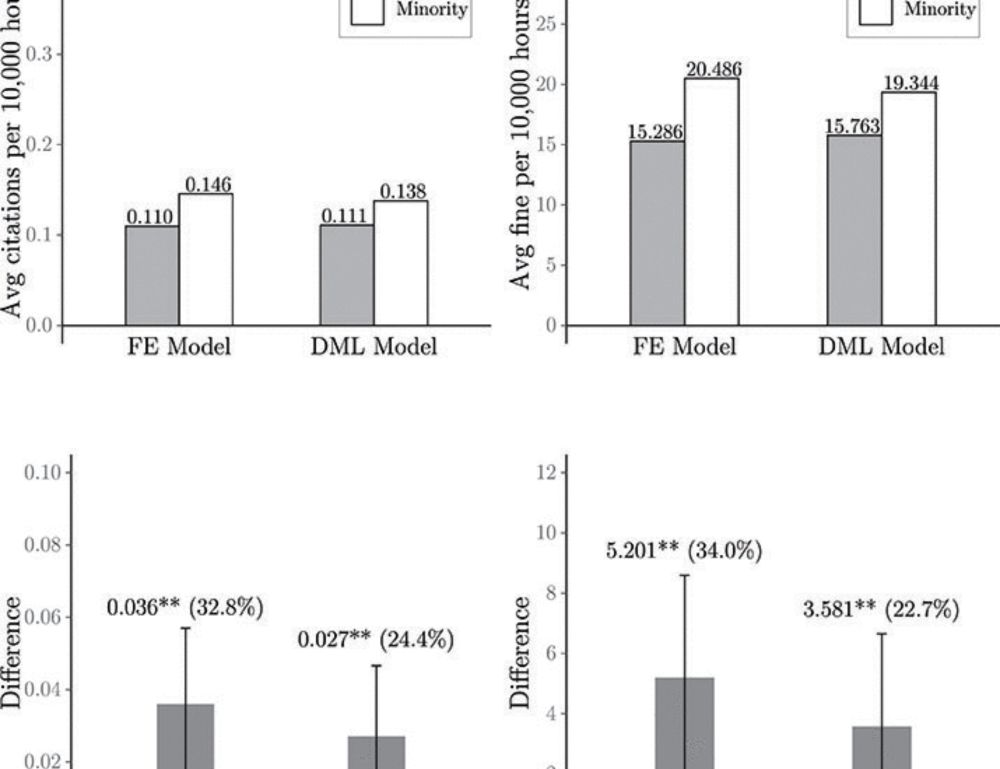
🧵In a recent IZA Discussion Paper, @stepanmikula.bsky.social, @tommasoreggiani.bsky.social, and I exploit a unique historical experiment that unfolded in post–World War II Czechoslovakia to study the long-term drivers of the accumulation of social capital.
🔗 Download: docs.iza.org/dp17981.pdf
1/12
10.07.2025 16:49 — 👍 10 🔁 3 💬 2 📌 1
Without executioners, there would be no executions.
Autocratic regimes rely on the legitimacy of their predecessors and the compliance of public employees at all levels.
Democracy may not die in applause, but it certainly perishes through (seemingly) minor compromises with evil.
12.06.2025 19:51 — 👍 0 🔁 0 💬 0 📌 0
Potřebujeme i lepší grantový systém, ale hlavně potřebujeme do vědy posílat více peněz přes institucionální financování kvalitních institucí.
31.03.2025 19:09 — 👍 0 🔁 0 💬 0 📌 0

Real photo of an econ seminar during the introduction slide:
30.03.2025 23:47 — 👍 344 🔁 25 💬 10 📌 4
Overview
National Elections Database
We are very happy to publish the "National Elections Database," including the results of 1,023 presidential and 2,962 parliamentary elections conducted worldwide since 1946!
www.nationalelectionsdatabase.com
with Benjamin Marx and Vincent Rollet
13.03.2025 12:20 — 👍 322 🔁 102 💬 10 📌 6
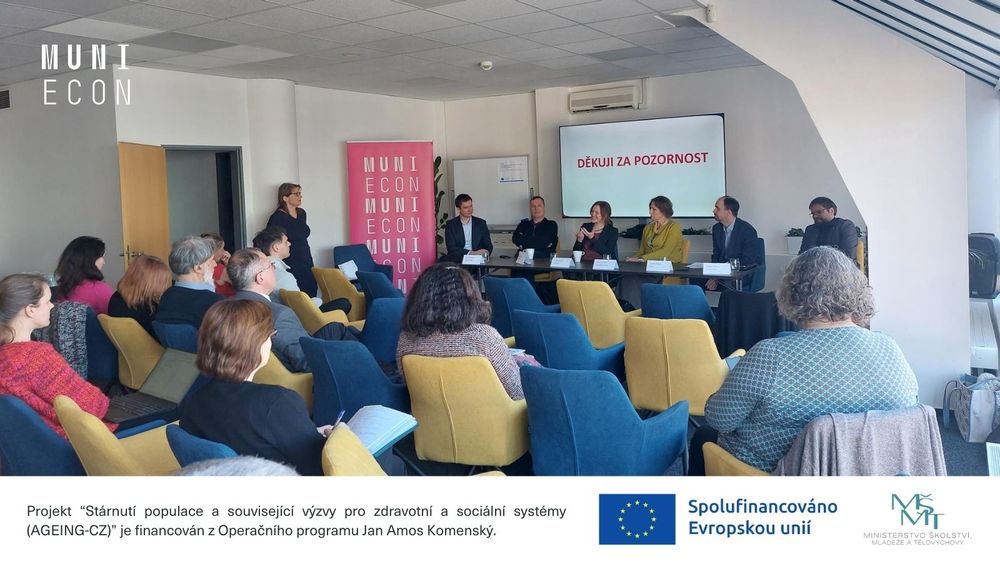
❔Jaká rizika přináší stárnutí populace? O tom diskutovali
🔹Ondřej Májek z ÚZIS
🔹ředitelka @recetox.bsky.social Jana Klánová
🔹vedoucí HEPII @jakubhlavka.bsky.social
🔹výzkumník trhu práce @stepanmikula.bsky.social
🔹vedoucí výzkumu CzechHTA ČVUT Aleš Tichopád
🔹MUDr. Hana Vaňková z @unikarlova.cuni.cz
18.02.2025 12:48 — 👍 1 🔁 2 💬 1 📌 0
I just don't recall Britain invading Czech lands (Czech Republic/ Bohemia/...).
13.02.2025 19:49 — 👍 0 🔁 0 💬 0 📌 0
inspektoři NAÚ trepky a svačinu a vyráží směrem Plzeň. Totéž bych čekal od rektora ZČÚ.
www.idnes.cz/plzen/zpravy...
A taktickou mělo být faktickou. Jej.
12.02.2025 07:17 — 👍 1 🔁 0 💬 0 📌 0
Baráky a studenti možná budou, ale kvalita stojí a padá s vyučujícími a ty jen tak přičarovat nelze - zvláště pokud budeme trvat na masové výuce v češtině.
Neznám taktickou situaci na ZČU, ale hádám, že po přečtení doporučení, že by si vyučující na univerzitě třeba mohli udělat i PhD balí
12.02.2025 07:14 — 👍 1 🔁 0 💬 1 📌 0
Takhle po dlouhé době otevřu článek na idnesu: "Důležité je, jak podpořit zájem pedagogů studovat PhD., což je pět let života." Fakulta zdravotnických studií Západočeské univerzity v Plzni.
Jedna se o hodnotný příspěvek do diskuse o zřizování a nafukování regionálních vysokých škol.
12.02.2025 07:11 — 👍 1 🔁 0 💬 1 📌 0
Naše národní opruzení zase tak moc nezůstává pozadu.
28.12.2024 05:29 — 👍 2 🔁 0 💬 0 📌 0
I am sure the bright people from StataCorp will do their best to keep the debate relevant.
15.12.2024 06:45 — 👍 0 🔁 0 💬 0 📌 0
Dovolil bych si jedno upřesnění. Navzdory zprávám o aktuálním dění v Brně stále platí to, že MUNI je univerzita, která jako přidruženou aktivitu provozovala kino. Opravdu to není naopak. Alespoň doufám.
13.12.2024 19:59 — 👍 1 🔁 0 💬 0 📌 0
What would the night sky look like at the edge of space?
08.12.2024 12:22 — 👍 0 🔁 0 💬 0 📌 0
Follow the arrows!
07.12.2024 18:40 — 👍 1 🔁 0 💬 1 📌 0
A mysterious murderer who never leaves a fingerprint and effortlessly climbs vertical glass surfaces? Sounds like A Nightmare on Wall Street.
02.12.2024 05:23 — 👍 1 🔁 0 💬 0 📌 0
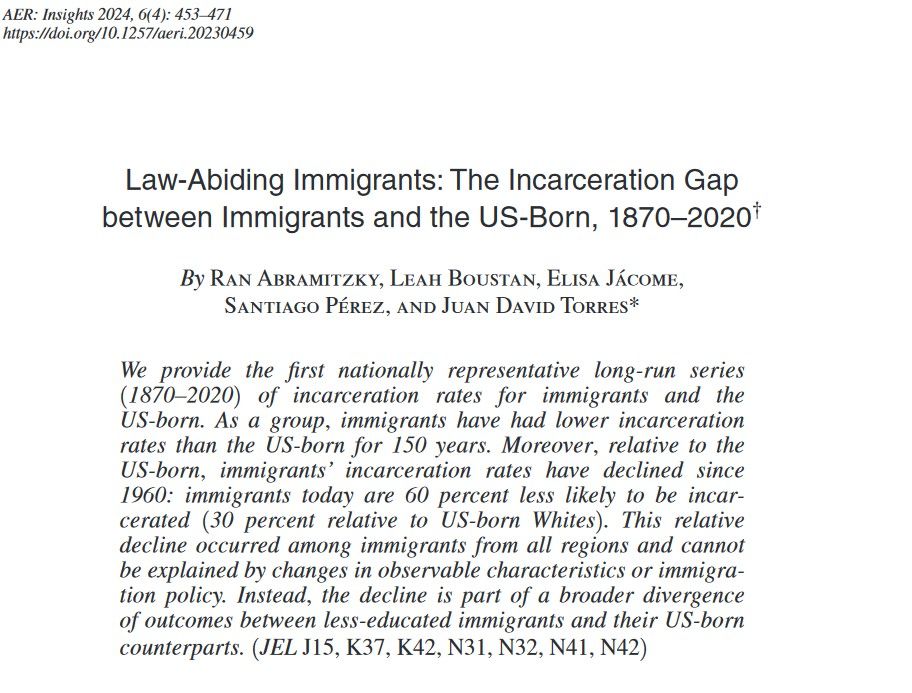
Law-Abiding Immigrants: The Incarceration Gap between Immigrants and the US-Born, 1870–2020†
By Ran Abramitzky, Leah Boustan, Elisa Jácome,
Santiago Pérez, and Juan David Torres*
We provide the first nationally representative long-run series (1870–2020) of incarceration rates for immigrants and the US-born. As a group, immigrants have had lower incarceration rates than the US-born for 150 years. Moreover, relative to the US-born, immigrants’ incarceration rates have declined since 1960: immigrants today are 60 percent less likely to be incarcerated (30 percent relative to US-born Whites). This relative decline occurred among immigrants from all regions and cannot be explained by changes in observable characteristics or immigration policy. Instead, the decline is part of a broader divergence of outcomes between less-educated immigrants and their US-born counterparts.
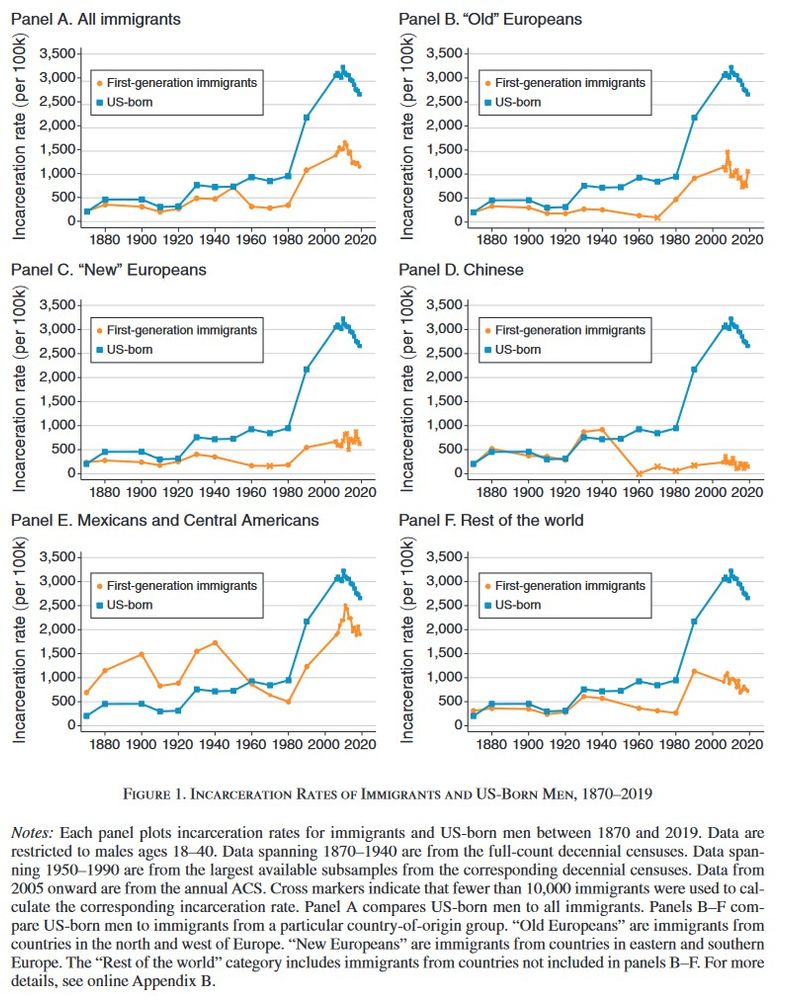
Panels plotting incarceration rates for immigrants and US-born men between 1870 and 2019. Data are restricted to males ages 18–40. Data spanning 1870–1940 are from the full-count decennial censuses. Data spanning 1950–1990 are from the largest available subsamples from the corresponding decennial censuses. Data from 2005 onward are from the annual ACS. Cross markers indicate that fewer than 10,000 immigrants were used to calculate the corresponding incarceration rate. Panel A compares US-born men to all immigrants. Panels B–F compare US-born men to immigrants from a particular country-of-origin group. “Old Europeans” are immigrants from countries in the north and west of Europe. “New Europeans” are immigrants from countries in eastern and southern Europe. The “Rest of the world” category includes immigrants from countries not included in panels B–F.
Migrants typically show lower incarceration rates
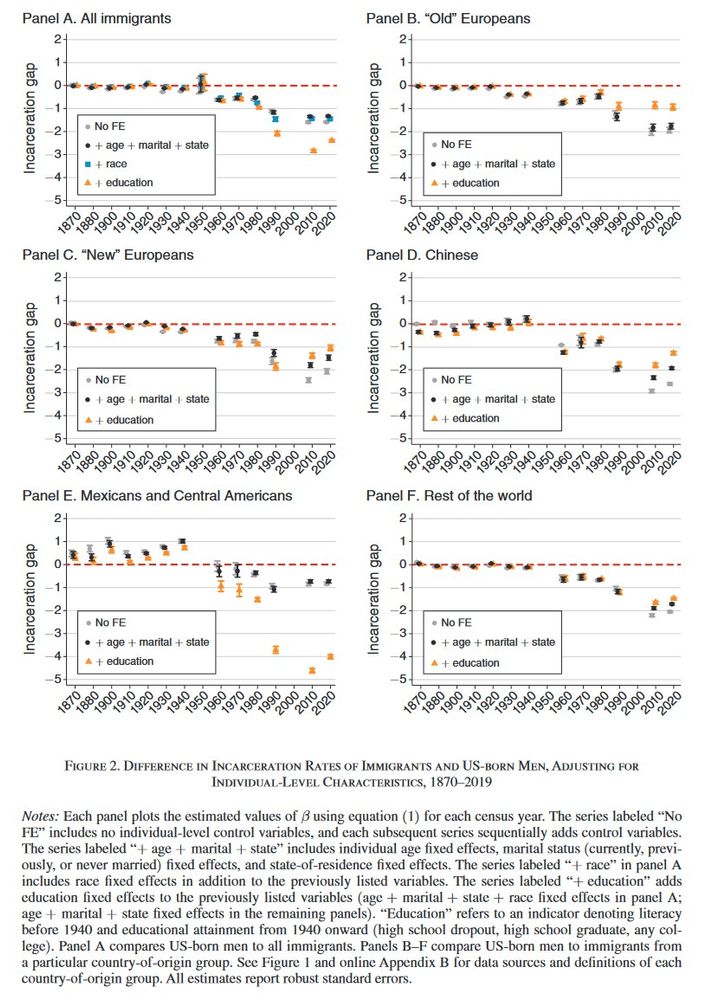
accounting for individual-level characteristics, migrants as a group or by subgroups (old Europeans, new Europeans, Chinese, Mexicans and Central Americans, or Rest of the World) are incarcerated at lower rates
I've posted several times about the working paper, but the publication on "AER: Insights" is a good occasion to do it again: immigrants to the US have been less likely to be incarcerated for over 50 years **even without controlling for demographic characteristics.**
www.aeaweb.org/articles?id=...
01.12.2024 22:30 — 👍 103 🔁 43 💬 2 📌 4

Explore open positions | Faculty of Economics and Administration, MU
For the following 4 years we will work on projects on health/labour/environmental aspects of population ageing and geographic/social peripheries.
For these projects we are looking for multiple postdocs. Follow me and @econmuni.bsky.social here or check our website: www.econ.muni.cz/en/about-us/...
01.12.2024 11:22 — 👍 7 🔁 3 💬 0 📌 1

"A mathematical visualization resembling a glowing, symmetrical diamond shape against a black background. The image is composed of overlapping translucent curves in turquoise, coral pink, and golden yellow, creating a flowing, wavelike pattern. The structure has four-fold rotational symmetry, with each quarter section containing gentle curves that spiral outward, forming bulges at the corners. The curves appear to have a ghostly, luminescent quality, giving the impression of light passing through layers of delicate glass.
Roots of parametric polynomials weaving a mesmerizing dance. ✨ #MathArt #Mathematics #Sciart
Made with #python #matplotlib #numpy #sympy"
29.11.2024 22:11 — 👍 102 🔁 13 💬 0 📌 0
It would take courage to call Czechoslovakia a capitalist country - which was the point.
It is difficult for me to discuss non-existent communist projects. When I close my eyes to imagine one, all I see is a prison either for the body or for the mind.
30.11.2024 17:28 — 👍 1 🔁 0 💬 0 📌 0

https://www.rknowledge.org/
We recently launched rknowledge.org - an interactive platform that provides advanced Knowledge Space indicators for over 1,000 regional economies across Europe and North America; intro: youtu.be/C4r2n258O08 and @regionalstudies.bsky.social publication: doi.org/10.1080/0034... (1/5)
30.11.2024 06:17 — 👍 29 🔁 14 💬 2 📌 0
It is actually good news b/c you don't need to wait that long.
Another example here: Some parts of the communist Czechoslovakia used to be one of the worst-polluted regions in Europe. You certainly don't need capitalism to have environmental damage.
28.11.2024 04:14 — 👍 4 🔁 0 💬 1 📌 0
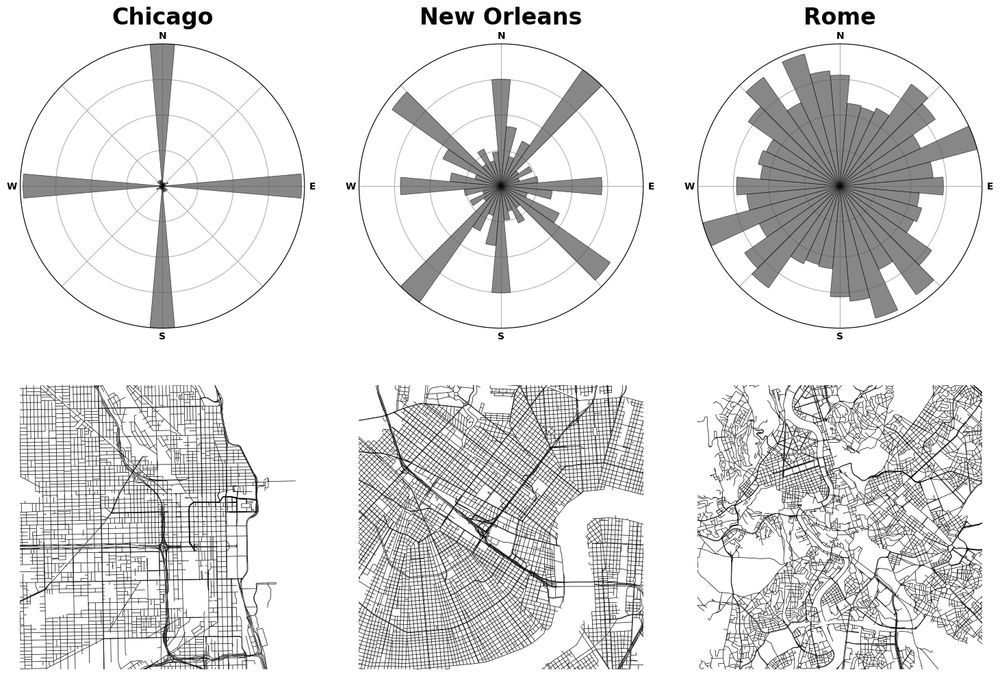
OSMnx 2.0.0 has been released! 🎉 This has been a massive effort over the past year to streamline the package's API, re-think its internal organization, and optimize its code. Today OSMnx is faster, more memory efficient, and fully type-annotated for a better user experience. 🧵
26.11.2024 16:29 — 👍 104 🔁 28 💬 1 📌 2
The number of Czech players in the WTA rankings is not that surprising anymore...
24.11.2024 17:09 — 👍 0 🔁 0 💬 0 📌 0
Received: 23 Sep 2024
Revised: 30 Oct 2024
Accepted: 1 Nov 2024
Published: 15 Nov 2024
To all PhD students at @econmuni.bsky.social This is NOT how decent (econ) journals work.
Maybe there are exceptions but this is not one of them.
23.11.2024 19:03 — 👍 1 🔁 1 💬 0 📌 0
Tak to je potom ještě dobrý ;-).
18.11.2024 11:53 — 👍 0 🔁 0 💬 0 📌 0
Lecturer @kcl-spe.bsky.social @kingscollegelondon.bsky.social
Game Theory, Econ & CS, Pol-Econ, Sport
Chess ♟️
Game Theory Corner at Norway Chess
Studied in Istanbul -> Paris -> Bielefeld -> Maastricht
https://linktr.ee/drmehmetismail
Views are my own
Political Science @fsv.charlesuni.cuni.cz
Political Parties | Information Flows | Defence Spending
https://jstauber.github.io/
🇮🇪🇧🇪 Econ PhD Candidate at EUI. Currently DGR @ecb. Macro with Heterogeneity, Inequality, IO & Productivity dynamics. Prev.
@ugent & @UCLouvain_be
Postdoctoral Researcher | Labor & Media Economics, Political Economy | firstgen
https://www.svenhartmann.com
Professor at Harvard Business School. Affiliate at NBER, CEPR, JPal. Cofounder at Explain. Column at Les Echos. Political economy, development, tech.
Research Fellow, University of Oxford
Theology, philosophy, ethics, politics, environmental humanities
Associate Director @LSRIOxford
Anglican Priest
https://www.theology.ox.ac.uk/people/revd-dr-timothy-howles
Researcher and photographer | Assistant Professor @ #HKU
Urban, transport & political #geography
#Critical #transport and #mobility, #politicaleconomy, #labour, #fares and #freepublictransport
Urban #alternatives
Local impact of #globalChina & #BRI
Almost a labor economist
PhD candidate in Economics @ROA, Maastricht
Labor/Education/Behavioral/Experiment Economics; Social Data Science
Views my own
zhuziyue.com
#econtwitter #econsky
PhD Candidate in labor and gender @Uppsala university.
https://sites.google.com/view/elinsundberg
Global Demography, Fertility, Aging, Cognition, Productivity, Religion. Interdisciplinarity.
Professor Columbia & Oslo - PI @theCEFH
https://scholar.google.com/citations?hl=no&user=OZOgxGEAAAAJ&view_op=list_works&sortby=pubdate
.
PostDoc, Economics Institute, University of Bamberg. Interested in all things distribution & networks. Dad of three. He/him.
International Political Economy, banking and finance, Eastern Europe, Associate Prof at the International Relations Department,
Central European University, Vienna
Journal of the American Geographical Society. In publication since 1852, the Geographical Review is the oldest journal in the United States devoted exclusively to geography. https://www.tandfonline.com/journals/utgr20
Associate professor at HVL business school, Western Norway University of Applied Sciences, Bergen, Norway.
PhD in Local Development.
Interested in innovation, technology, economic geography, social networks, sustainability transitions, culture.
Brazilian Economist at @ipeaonline; professor at @SejaIDP; @CNPq_Oficial
Opinions are solely mine (or stolen from others)
https://sites.google.com/view/lmonasterio
#econsky
Researcher at @bundesbank.de Research Center. Working on Housing, Macro & Family.
Formerly at @umichECON, @cerge-ei-found.bsky.social and as a forecaster at #RSQE@umich.
Professor of Urban Policy, Melbourne, posting/following mostly academically on housing, transport, planning, infrastructure, energy, governance, geography, and climate.
If I followed you it is probably via a starter pack (not personal).
Also @ X, 🐘, 🪡
The IESI conducts community centred interdisciplinary research and knowledge exchange to build a more inclusive society @ the University of Sunderland
Health Economist at University of Rome Tor Vergata.
Local PI @obeliskproject.bsky.social
@stageprojecteu.bsky.social
Sometimes antisocial, always antifascist
https://andreapm1977.github.io/andreapm_web/


